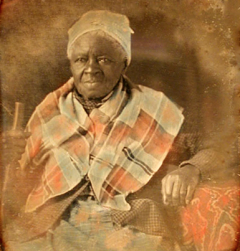 History
History
The term “mammy” in the American Southland remained in widespread use through the early 1980s as a term of great respect for any Black women who took care of white children. In the South it is still not proper to refer to anyone as God Father or God Mother, as this is thought to be anti-Christian. Rather, the Southern people (both white and Black) use “Aunt” and “Uncle” to show respect for unrelated elders.
One of the earliest fictionalized versions of the mammy figure was Aunt Chloe in Harriet Beecher Stowe’s Uncle Tom’s Cabin (1852). As the mammy figure progressed into the 20th century, the persona was sacrificed to the demands of the white majority, who widely mythologized the figure. Even memoirs which describe the roles of mammies from the 1890s to the 1920s downplayed the mammy’s relationship with her family.
Characteristics
The mammy often had physical attributes that the Western culture would associate with masculinity. The mammy was usually a grossly overweight, large-breasted woman who is desexualized, maternal, and nonthreatening to white people but may be hostile towards men. Many of these characteristics were denied to African American female slaves but were generally attributed to the mammy.
The dress often reflected the status of her owner or employer. The mammy was usually neat and clean and wore attire that was suitable for her domestic duties. Sometimes a mammy considered herself to be “dressed up”, but that was usually just an addition of a bonnet and a silk velvet mantle, which probably belonged to her mistress. Sometimes she would even don a Sunday black silk.
Like most of the slaves at that time, the mammy was often illiterate though intelligent in her own sense. Among many of the slaves, there could have been a mammy who possessed the abilities to read and write, often taught to her by the children of the family for whom she worked. However, as intelligent as she might have been, most of her intelligence was a result of past experiences and conflicts. In particular, a mammy of an aristocratic family could be identified by her air of refinement.
When the mammy did not stay in the house of her master or was not busy attending to the needs of the master’s children, she would usually live in a cabin that was distinguished differently than the cabins of the other servants in either size or structure with her husband and children. Her cabin stood near the “big house”, or the master’s house but at a distance from the cabins of the other servants.
Although the duties were far less tiring and strenuous than those of the other servants, her hours were often long, leaving little time for her own leisure. It was not until the mammy had become too old for these duties that she would enjoy any home life of her own, since she was always preoccupied with the home life of her master. There was a flexibility about the mammy’s duties that distinguished her from just being an ordinary nurse or a wet nurse, even though there was a possibility that she could perform either of these tasks. In some of the more wealthy households, the mammy had assistants that would help her take care of the household’s children. These women were often much younger than the mammy herself.
The mammy, unlike the other servants, was usually not up for sale, and the children of the mammy would be kept in the same family for as long as possible, retaining the same relationships that the mammy had with the master.
Roles in plantation households
The role of the mammy in plantation households grew out of the roles of African American slaves on the plantation. African American servants played vital roles in the plantation household. The majority of these duties generally were related to caring for the children of the family, thus relieving the mistress of the house of all the drudgery work that is associated with child care. When the children had grown up and were able to take care of themselves properly, the mammy’s main role was to help the mistress with household tasks. As her years of service with the family increased, the mammy’s sphere of influence increased as well. She was next to the mistress in authority and had the ability to give orders to everybody in the house.
The mammy was often considered to be part of the family as much as its blood members were considered. Although she was considered of a lower status, she was still included in the inner circle. She has often been referred to as a “unique type of foster motherhood.” Aside from just tending to the needs of the children, the mammy was also responsible for teaching the proper etiquettes to them, such as addressing the elders on the plantation as “aunt” or “uncle”, as well as what was best to say on a particular occasion and what was not. The mammy was able to discipline their children whenever they performed something undesirable and was able to retain their respect towards her, even after the children had grown to adults.



